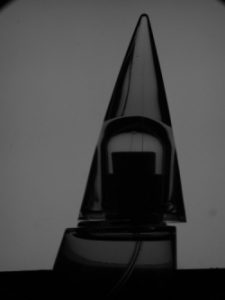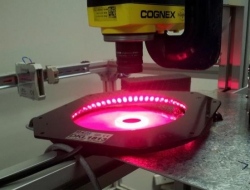Lighting is, arguably, the most important part of a vision system. After all, without light there is no sight.
Because cameras are so much less versatile and adaptive than the human eye, we need to optimise lighting conditions so that cameras can produce the best images possible. Cameras see the light reflected back from objects, rather than the objects themselves. By controlling the illumination we can control how objects appear to the camera.
 Light is reflected differently from an aerosol can, for example, than from a crisp packet or paper label. Different lighting technologies will be appropriate for each example, and the choice of lighting will also depend on why we’re looking at the objects.
Light is reflected differently from an aerosol can, for example, than from a crisp packet or paper label. Different lighting technologies will be appropriate for each example, and the choice of lighting will also depend on why we’re looking at the objects.
Inadequate illumination can make the difference between a reliable vision system and one that just isn’t up to the job. Optimised lighting can save processing time later on – and ultimately improve efficiency – as well as giving a much better result.
By using a combination of different lighting systems and filters, we can make sure that the best illumination is selected for each individual job.
Filters
One thing that is often overlooked when designing and implementing a vision system is random variables. Vision systems need a rigidly-controlled lighting scheme to work at their best: there’s no point in setting up a camera with a great lighting system to read details on, for example, packing boxes in an area where light changes throughout the year. Or perhaps someone will come along with a torch; again, this will detract from the results of the inspection.
Even if there’s no advantage to the contrast, we’ll use a light and filter that’s appropriate for removing all other light in the room. Controlling the variables is key. Even a chap in a high-vis jacket can undo all your good work.
Lighting for accuracy
Did you know that you’ll get a better image from monochromatic light? White light produces a “fuzzy” image, because it’s made up of a broad spectrum of electromagnetic wavelengths. This means that the resulting image is an “average” based on the different frequencies of light in the source. Sharper images are much better for metrology, for example, when sharp edges and sub-millimetre measurements are important.
 Coloured light gives excellent contrast to the object that will be imaged. For example, he best image of a red item may well be produced using a green light, so take a look at a colour wheel, and try using the opposite colour to your item.
Coloured light gives excellent contrast to the object that will be imaged. For example, he best image of a red item may well be produced using a green light, so take a look at a colour wheel, and try using the opposite colour to your item.
Don’t be limited by your eyes, either. We produce vision systems that use light outside the visible range, such as infrared or ultraviolet. Infrared, for example, will (if you’re lucky) give you a view of what’s under opaque lids. So if you need to check that the push-buttons on hairsprays are correctly fitted, but you can’t take the lids off to check – give us a call!
Infrared is also very good at spotting the difference between organic and inorganic elements; for example, nuts vs. stones in a nut-packing factory.
Let there be light
This quick overview of lighting and filters should give you the idea that the correct lighting is really important for a job well done; but in some industries, it’s not just about efficiency it’s about safety. Medical instruments, aeroplane parts, and automobile parts are made to extremely tight specifications and tolerances, so the manufacturers need to be absolutely positive that everything is present and correct.
There are an enormous number of lighting and filter combinations for almost any job imaginable. We’ll be going into a bit more detail about different types of lighting, such as LED, laser, incandescent, thermal, so keep an eye on the blog for more information.
